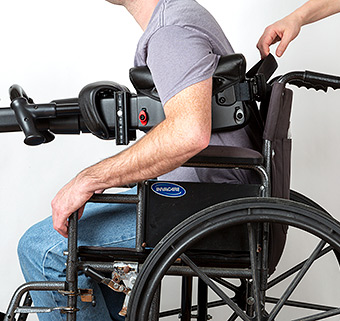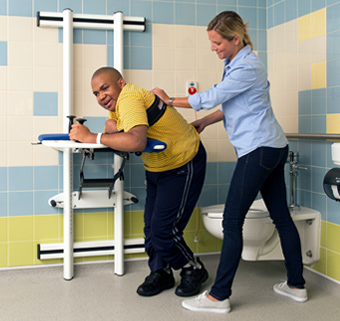Adopting Safe Patient Handling Policy in School
An Interview with Jill Barrett, MS, PT
| June 2015 Safe patient handling and mobility (SPHM) as a discipline is gaining momentum not only in hospitals and rehab facilities but in schools as well. High Desert Education Service District, based in Redmond, Oregon, serving multiple districts across a large area, recently implemented a new SPHM policy. Recently Rifton spoke with Jill Barrett about the importance of safe patient handling in schools. A tireless advocate, Jill works to raise awareness, implement minimal lift policies and create a culture of safety for students and staff in her district schools. Her success shows in decreased injury rates, decreased worker’s comp claims and staff and students who feel safe and secure during daily lifts and transfers. We asked Jill to share some tips and advice from her experience.
Safe patient handling and mobility (SPHM) as a discipline is gaining momentum not only in hospitals and rehab facilities but in schools as well. High Desert Education Service District, based in Redmond, Oregon, serving multiple districts across a large area, recently implemented a new SPHM policy. Recently Rifton spoke with Jill Barrett about the importance of safe patient handling in schools. A tireless advocate, Jill works to raise awareness, implement minimal lift policies and create a culture of safety for students and staff in her district schools. Her success shows in decreased injury rates, decreased worker’s comp claims and staff and students who feel safe and secure during daily lifts and transfers. We asked Jill to share some tips and advice from her experience.
Why is SPHM important for the school-based practice setting?
SPHM advocates for the use of mechanical devices to take the place of manually lifting and transferring people with disabilities. In assessing the work-related injuries in our school district (with the help of consultants from our state’s accident insurance fund), we discovered a disproportional number of injuries in special education compared to regular education. Within special ed, student-assisted transfers was the category of greatest injury cost. Because of this I consider special ed a high-risk job.
How do you define a student assisted transfer? What are the risks?
A student-assisted transfer is one which requires hands-on physical assistance to move a student. There are high compression and shear forces created in the spine when physically assisting someone to move, which damages the tissues of the spine. This effect is exacerbated if the student is heavy or uncooperative. NIOSH recommends a patient lifting limit of 35 pounds, but in reality there is no safe amount to lift.
What changes did you propose to decrease the risk of injury from student-assisted transfers in your district?
Although many hospitals and rehab facilities around the country have no-lift policies, we modified that to minimal-lift as some therapists in our district work with infants and toddlers in birth-to three programs so a no-lift policy would not be reasonable.
Based on evidence and the safe single person lifting policies of other school districts, including the Hawaii Department of Education, we decided on a 30 pound maximum for a single person dependent lift. Additionally, we decided upon NO two-person lifts or transfers. If a student could not safely, reliably and cooperatively stand and pivot for a student-assisted transfer then we used safe patient handling devices such as standing patient lifts, overhead lift frames and the Rifton TRAM.
A couple tips we discovered that improved the implementation of our new policy: 1. We did not place a student on a floor mat if we did not have a means to safely get him or her back up. We used mat tables instead, and 2, Instead of placing staff and students at risk during a stand-pivot transfer that was not yet mastered, we practiced components of those maneuvers in a safe manner at other times of day.
How did you convince administration to support the minimal lift changes?
Our first step was to agree as a group of physical therapists to the changes we would recommend. Then we met with our supervisor who invited us to come to the special ed director regional meeting. There we got unanimous support, so throughout the year we gave inservices and raised awareness on safe patient handling.
Again, a couple of tips we discovered: 1, Seek out insurance carrier safety consultants when available to help gather injury data. This gives you great leverage when making the case for minimal lift policies. Otherwise cite the abundant evidence relating to safe patient handling, showing clear relationships between manual patient transfers and injuries. Additionally, calculate the total number of pounds moved per day by the staff; this is an impressive and even shocking statistic. 2, Partner with special ed directors early on. Use the injury/time loss/cost argument: It is cheaper to purchase transfer and lifting equipment than to pay for increasing worker’s comp insurance rates and the indirect costs of hiring and re-training substitutes or replacements.
What are some common challenges to implementing a no-lift program and how did you overcome them?
Amazingly enough, some of our greatest push-back came from the school staff. We worked hard to explain to the staff that these changes are FOR THEM, that it is our job to take care of them and that we are investing in equipment in order to do so. It was helpful to show them injury data across the region and to explain that they could be one of the statistics in the injury bar graph.
Another challenge has been addressing the perception that a manual lift of one or two people is somehow more caring and nurturing. Staff often feel rushed and the manual lift is almost always quicker. We explained that by using mechanical devices we are ensuring the likelihood that staff remain uninjured in order to work with the student, that getting injured removes them from the student. It is therefore most nurturing to beat the odds to remain and work with the student. As for time urgency, we say that only a true emergency of a nearby fire or other hazard requires sacrificing yourself. Otherwise, always use equipment. If a student is chronically late in their schedule due to use of a mechanical lift or transfer device then we offer to be the advocate to meet with school personnel to explain the need for updating the student’s schedule to allow more time for safer transfers.
Could you provide an example of injury rates before and after the no-lift policy was implemented in your school district?
Yes. Our insurance safety consultants provided graphs of the number of worker’s comp claims related to student-assisted transfer injuries for our school district over the last four school years. In the three years before our minimal lift policy was implemented, reported injuries ranged between five and eight a year. After implementing our minimal lift policy as of this school year, we have so far been injury free with student assisted transfers.
How did you secure funding for lift and transfer equipment to complement the minimal lift policies?
In our agency each school district pays into our Assistive Technology program and in doing so, they get whatever equipment a student needs for their IEP or 504 plan. After our initiative to raise awareness in safe patient handling and mobility our agency began purchasing more Rifton TRAMS, hoyer-type lifts and standing patient lifts. Overhead lift frames, hi-lo changing tables, mat tables and wall-mounted devices were the responsibility of the individual districts. We found it’s helpful to prioritize classrooms of highest risk for the purchase of equipment. One district purchased overhead lift frames targeting one school per year in both classroom and bathroom.
What role does the TRAM play in the changes you made to student-assisted transfers?
School staff describe the Rifton TRAM as a “godsend.” It enables students who otherwise could not safely and reliably stand and pivot for a transfer to practice their standing skills safely. It often means that only one adult caregiver is needed.
Before the TRAM, some non-weight-bearing students had to be transferred with a hoyer-type sling lift to a changing table for pants management and then transferred again to a toileting support device. With the TRAM, students are transferred directly to a toilet and pants are managed right there in a much more dignified and efficient process.
An additional bonus is that the TRAM doubles as a gait trainer. And staff report that when using the TRAM they feel “safe and secure” and they know their students are more safe and secure during all transfers and gait training routines.
Do you have any parting words or encouragement to share with readers who may be interested in implementing a similar policy in their school districts?
Yes. First of all, it is important to recognize that within our school district we succeeded implementing minimal lift policies on a larger scale. That may not be possible in other large districts. I would recommend targeting the neediest schools, programs or students first. But every TRAM or standing patient lift obtained and put into practice makes a big difference. Therapists may be able to develop short and long-term plans to make safe patient handling a success.
And one final and important point I would like to make is that we in education often think that the way things are is the way things have to be. We feel powerless to change very poor environmental set-ups. And while it’s true there is not much money in education, at least in Oregon, compared to the medical system, we do not have to (and should not) settle for poor set-ups and inadequate equipment. There are plenty of research and case projects out there to show that training in safe lifting is not what prevents injuries. It is equipment.




